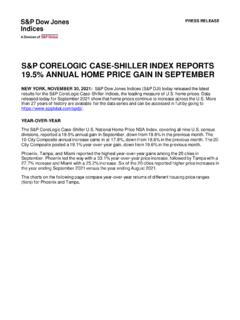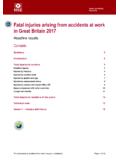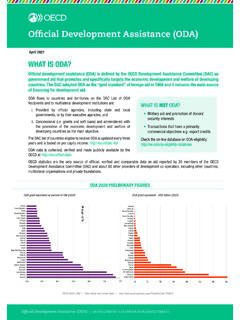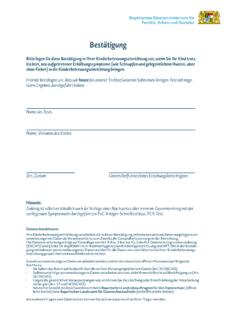Transcription of The Economics of Biodiversity The Dasgupta Review ...
1 The Economics of Biodiversity : The Dasgupta ReviewHeadline MessagesThe Economics of Biodiversity : The Dasgupta ReviewHeadline MessagesFebruary 2021 Crown copyright 2021 This publication is licensed under the terms of the Open Government Licence except where otherwise stated. To view this licence, visit we have identified any third party copyright information you will need to obtain permission from the copyright holders concerned. Front cover photograph: Cruz ErdmannThis publication is available at: enquiries regarding this publication should be sent to us at 978-1-911680-31-4PU 3071 CCS1120604514 02/21 The Economics of Biodiversity : The Dasgupta Review headline Messages1 Our economies, livelihoods and well-being all depend on our most precious asset: are part of Nature, not separate from it. We rely on Nature to provide us with food, water and shelter; regulate our climate and disease; maintain nutrient cycles and oxygen production; and provide us with spiritual fulfilment and opportunities for recreation and recuperation, which can enhance our health and well-being.
2 We also use the planet as a sink for our waste products, such as carbon dioxide, plastics and other forms of waste, including pollution. Nature is therefore an asset, just as produced capital (roads, buildings and factories) and human capital (health, knowledge and skills) are assets. Like education and health, however, Nature is more than an economic good: many value its very existence and recognise its intrinsic worth enables Nature to be productive, resilient and adaptable. Just as diversity within a portfolio of financial assets reduces risk and uncertainty, so diversity within a portfolio of natural assets increases Nature s resilience to shocks, reducing the risks to Nature s services. Reduce Biodiversity , and Nature and humanity have collectively failed to engage with Nature sustainably, to the extent that our demands far exceed its capacity to supply us with the goods and services we all rely on.
3 We are all asset managers. Individuals, businesses, governments and international organisations all manage assets through our spending and investment decisions. Collectively, however, we have failed to manage our global portfolio of assets sustainably. Estimates show that between 1992 and 2014, produced capital per person doubled, and human capital per person increased by about 13% globally; but the stock of natural capital per person declined by nearly 40%. Accumulating produced and human capital at the expense of natural capital is what economic growth and development has come to mean for many people. In other words, while humanity has prospered immensely in recent decades, the ways in which we have achieved such prosperity means that it has come at a devastating cost to Nature. Estimates of our total impact on Nature suggest that we would require Earths to maintain the world s current living Review calls the imbalance between our demands and Nature s supply the Impact Inequality.
4 Those demands are affected by the size and composition of our individual demands, the size of the human population, and the efficiency with which we both convert Nature s services to meet our demands and return our waste back into Nature. Nature s supply is affected by the stock of natural assets and its ability to regenerate. Our unsustainable engagement with Nature is endangering the prosperity of current and future generations. Biodiversity is declining faster than at any time in human history. Current extinction rates, for example, are around 100 to 1,000 times higher than the baseline rate, and they are increasing. Such declines are undermining Nature s productivity, resilience and adaptability, and are in turn fuelling extreme risk and uncertainty for our economies and well-being. The devastating impacts of COVID-19 and other emerging infectious diseases of which land-use change and species exploitation are major drivers could prove to be just the tip of the iceberg if we continue on our current path.
5 Many ecosystems, from tropical forests to coral reefs, have already been degraded beyond repair, or are at imminent risk of tipping points . These tipping points could have catastrophic 2 The Economics of Biodiversity : The Dasgupta Review headline Messagesconsequences for our economies and well-being; and it is costly and difficult, if not impossible, to coax an ecosystem back to health once it has tipped into a new state. Low income countries, whose economies are more reliant than high income countries on Nature s goods and services from within their own borders, stand to lose the most. Reversing these trends requires action now. To do so would be significantly less costly than delay, and would help us to achieve wider societal goals, including addressing climate change (itself a major driver of Biodiversity loss) and alleviating the heart of the problem lies deep-rooted, widespread institutional failure.
6 Nature s worth to society the true value of the various goods and services it provides is not reflected in market prices because much of it is open to all at no monetary charge. These pricing distortions have led us to invest relatively more in other assets, such as produced capital, and underinvest in our natural assets. Moreover, aspects of Nature are mobile; some are invisible, such as in the soils; and many are silent. These features mean that the effects of many of our actions on ourselves and others including our descendants are hard to trace and go unaccounted for, giving rise to widespread externalities and making it hard for markets to function well. But this is not simply a market failure: it is a broader institutional failure too. Many of our institutions have proved unfit to manage the externalities. Governments almost everywhere exacerbate the problem by paying people more to exploit Nature than to protect it, and to prioritise unsustainable economic activities.
7 A conservative estimate of the total cost globally of subsidies that damage Nature is around US$4 to 6 trillion per year. And we lack the institutional arrangements needed to protect global public goods, such as the ocean or the world s 15th Conference of the Parties to the Convention on Biological Diversity (COP15) and the 26th Conference of the Parties to the UN Framework Convention on Climate Change (COP26) provide important opportunities to set a new, ambitious direction for the coming decade, and establish the right environment to deliver on commitments made and the institutional arrangements needed to ensure those commitments are solution starts with understanding and accepting a simple truth: our economies are embedded within Nature, not external to it. While most models of economic growth and development recognise that Nature is capable only of producing a finite flow of goods and services, the focus has been to show that technological progress can, in principle, overcome that exhaustibility.
8 This is to imagine that, ultimately, humanity is external to Nature. The Review develops the Economics of Biodiversity on the understanding that we and our economies are embedded within Nature, not external to it. The Review s approach is based firmly in what we know from ecology about how ecosystems function, and how they are affected by economic activity, including the extraction of natural resources for our production and consumption, and the waste we produce through these activities, which ultimately damages ecosystems and undermines their ability to provide the services on which we rely. This approach helps us to understand that the human economy is bounded and reshapes our understanding of what constitutes truly sustainable economic growth and development: accounting fully for the impact of our interactions with Nature and rebalancing our demand with Nature s capacity to supply.
9 The Economics of Biodiversity : The Dasgupta Review headline Messages3We need to change how we think, act and measure success. Humanity faces an urgent choice. Continuing down our current path where our demands on Nature far exceed its capacity to supply presents extreme risks and uncertainty for our economies. Sustainable economic growth and development requires us to take a different path, where our engagements with Nature are not only sustainable, but also enhance our collective wealth and well-being and that of our descendants. Choosing a sustainable path will require transformative change, underpinned by levels of ambition, coordination and political will akin to, or even greater than, those of the Marshall Plan. The change required should be geared towards three broad transitions. (i) Ensure that our demands on Nature do not exceed its supply, and that we increase Nature s supply relative to its current production is the most significant driver of terrestrial Biodiversity loss.
10 As the global population grows, the enormous problem of producing sufficient food in a sustainable manner will only intensify. Technological innovations and sustainable food production systems can decrease the sector s contribution to climate change, land-use change and ocean degradation; reduce environmentally damaging inputs and waste; improve production system resilience, through methods such as precision agriculture, integrated pest management and molecular breeding techniques; and are likely to have a positive economic impact, including the creation of jobs. Demand for energy is a major contributor to climate change and resulting Biodiversity loss. Decarbonising our energy systems is a necessary part of balancing demand and if we are to avoid exceeding the limits of what Nature can provide on a sustainable basis while meeting the needs of the human population, we cannot rely on technology alone: consumption and production patterns will need to be fundamentally restructured.

















